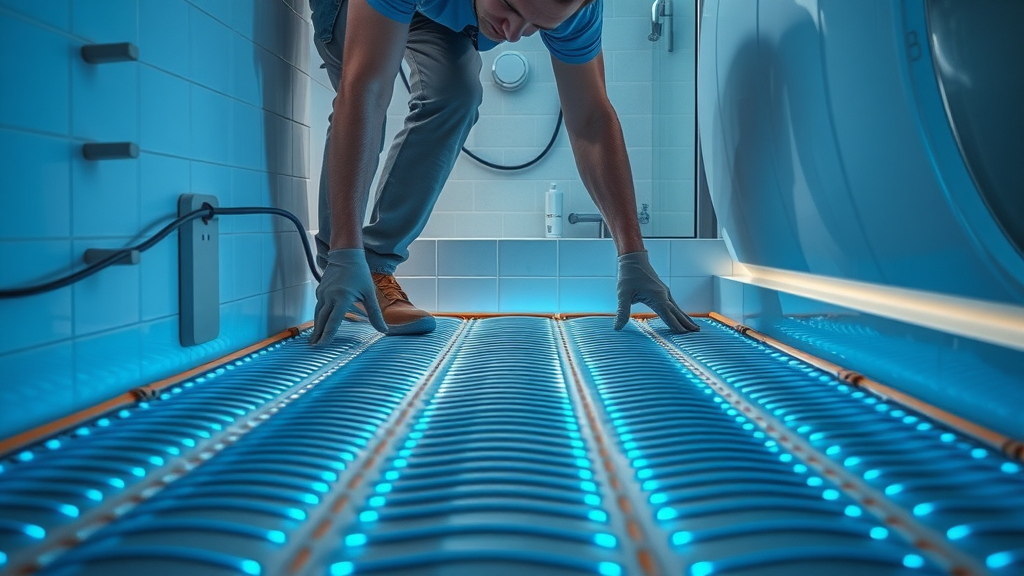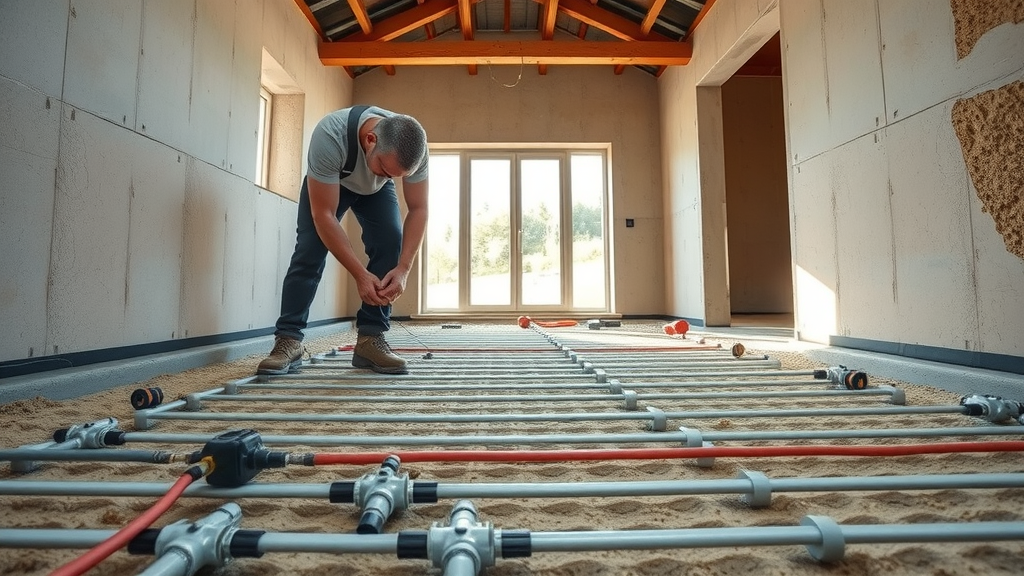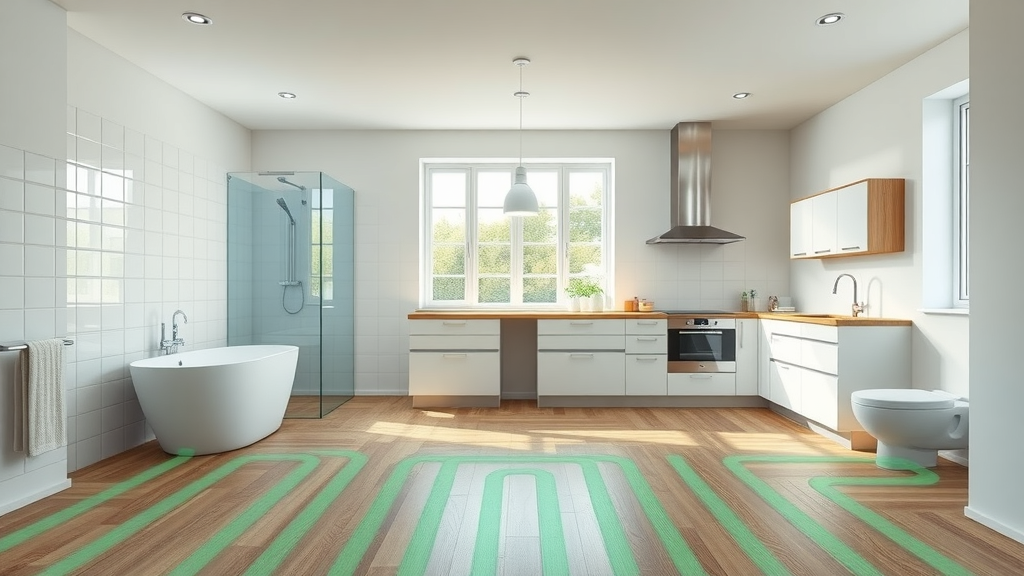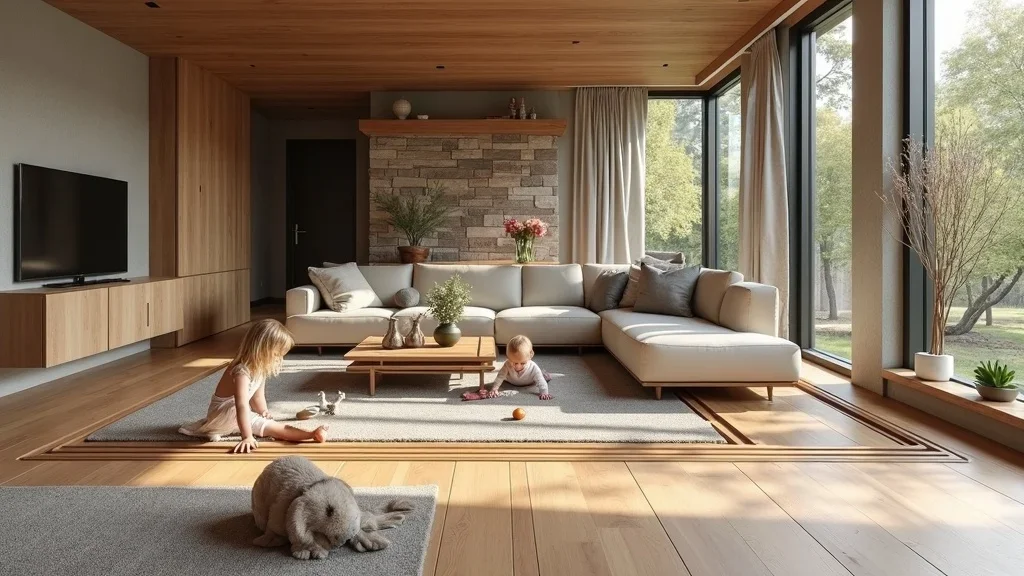Ever wondered if underfloor heating could transform your daily comfort while saving money in the long run? With so many heating choices out there, is it really the smartest move for your home – or just a modern luxury? In this guide, we dive deep into floor heating, busting myths and serving up clear insights to help you decide confidently. Whether you’re exploring options for a major renovation or just curious about a cosier future, you’re about to discover everything you need to know about underfloor heating and its true value.
Is Underfloor Heating Worth It? An Introduction That Challenges Common Heating Choices
The question is underfloor heating worth it? is becoming increasingly vital as homeowners seek both comfort and efficiency. Traditional radiator-based heating systems have been the UK norm for decades, but advances in heating technology and a growing focus on energy efficiency have placed floor heating centre stage. Property owners and their advisors must determine not only if underfloor systems provide superior cosiness but also if the initial investment pays back through lower energy bills and higher property value.
While radiators can efficiently heat a room, they often create hot and cold spots, lead to space constraints, or get in the way during room redesigns. Underfloor heating offers a powerful alternative, supplying warmth from the ground up and promising seamless integration with modern and period homes alike. This guide aims to cut through confusing jargon and conflicting claims and give you practical, expert-backed information, so you can make the best decision for your household's comfort and long-term savings.

What You'll Learn From This Guide to Underfloor Heating
- The essentials of underfloor heating and floor heating technologies
- Pros and cons of electric underfloor heating and wet systems
- Comparative running cost analysis
- Impact on energy bills and home value
- Key considerations for installation and maintenance
- How Peak Underfloor Heating Ltd can support your project
Understanding Underfloor Heating: The Modern Heating System Alternative
Floor heating has fundamentally changed how we approach home comfort. Underfloor heating is a type of heating system that distributes warmth beneath your feet, eliminating the need for bulky radiators and ensuring a consistent temperature throughout the room. Both electric underfloor heating and wet systems are designed to integrate with a variety of floor constructions, offering an ideal solution for both new-builds and renovation projects alike.
Unlike old-fashioned radiators that heat a room through convection (warming the air), underfloor heating creates gentle, radiant heat that rises evenly from the entire floor surface. This method mimics the natural warmth of sunlight and helps stabilise humidity and air quality. Plus, because floor heating operates at lower water temperatures — often in tandem with energy-efficient heat pumps — it's a truly modern approach to home heating that aligns perfectly with today's sustainability goals.
What is Underfloor Heating and How Does It Work?
Underfloor heating systems work by installing either electric cables (in electric underfloor heating) or water-filled pipes (wet systems) beneath your floor surface. These systems are typically laid over insulation boards before the final floor covering is fitted. Once the system is turned on, heat radiates gently from the entire floor, ensuring every corner of the room enjoys the same level of comfort — no cold spots, no uneven heating.
"Underfloor heating creates radiant warmth from the ground up, providing even heat distribution and unrivalled comfort." — Peak Underfloor Heating Ltd
The main types of underfloor heating make use of lower operating temperatures compared to conventional central heating systems, which can translate directly into reduced energy usage. With underfloor heating, you have more flexibility in interior design, as you can remove wall-mounted radiators and optimise every square metre of your living space. Warm floors, lower drafts, and a constant ambient temperature are just some of the reasons underfloor heating is soaring in popularity across the UK.
Types of Underfloor Heating Systems: Electric vs Wet Systems
There are two main types of underfloor heating: electric underfloor heating (also called “dry” systems) and wet underfloor heating (hydronic systems). Each has its ideal application, benefits, and installation requirements.
Choosing between electric and wet systems often comes down to property type, floor construction, and budget. For example, electric underfloor heating is often selected for smaller spaces or single rooms (like bathrooms), while wet systems are popular for larger areas and full-home installations, especially in new builds or major renovations.
Electric Underfloor Heating: Application and Benefits
Electric underfloor heating systems use heating mats or loose cables installed directly under the floor covering. These systems fit particularly well in retrofit projects where minimising floor height build-up is essential. The heating mat is simply rolled out and connected to the mains electricity supply, making the installation process relatively straightforward and quick compared to wet systems.

One of the standout advantages of electric underfloor heating is its responsiveness — it heats up quickly, providing almost instant comfort. This system is often chosen for bathrooms, kitchens, and extensions where running new pipework might be impractical. Electric underfloor heating is compatible with most flooring types, including tiles, laminate, and engineered wood, making it flexible for a variety of room designs.
Wet Underfloor Heating: The Hydronic Alternative
Wet systems (also called hydronic underfloor heating) involve laying a network of pipes through which warm water circulates, connected to your existing central heating system or heat pump. Wet underfloor heating is known for its long-term efficiency and suitability for heating large spaces, such as open-plan living areas, ground floors, or full homes.
Although wet systems require a higher installation cost and more invasive prep work — often needing the floor to be raised and screeded — the result is an energy-efficient heating system that operates at low temperatures. When paired with energy sources like heat pumps, wet underfloor heating delivers exceptional running cost savings and comfort in the long run. It's the preferred solution for new builds or substantial renovations where you want to maximise comfort, lower your energy bill, and future-proof your home against rising energy prices.
| Feature | Electric Underfloor Heating | Wet Underfloor Heating |
|---|---|---|
| Best Application | Bathrooms, kitchens, small rooms, retrofits | Open-plan rooms, full-house, new builds & extensions |
| Installation Cost | £75–£130 per m² (lower for small areas) | £120–£200+ per m² (higher for retrofits) |
| Running Costs | Potentially higher per kWh, costs vary by usage | Lower when used with condensing boilers or heat pumps |
| Maintenace | Minimal, mainly electrical checks | Virtually maintenance-free if installed well |
| Retrofit Suitability | Excellent for most floor constructions | Requires more complex install, best for major renovations |
The Pros: Why Underfloor Heating Might Be Worth It
- Energy-efficient heating system reduces energy bills
- Improved comfort and even floor heating distribution
- Low profile and space-saving advantages
- Quiet operation and modern appeal
One of the most compelling reasons homeowners choose underfloor heating is the unbeatable comfort it brings. The entire floor heats up, eliminating chilly spots and allowing you to walk barefoot throughout the coldest months. Floor heating also means there's no need for visible radiators, giving you a clutter-free look and more freedom in arranging furniture. Unlike conventional heating systems that can be noisy, underfloor installations run silently, preserving the peacefulness of your living space.
"Clients particularly enjoy underfloor heating's seamless aesthetic, as it eliminates radiators and maximizes living space for residential renovations." – Peak Underfloor Heating Ltd Expert
Another major advantage is energy efficiency: because underfloor systems work at lower temperatures, your boiler (or heat pump) doesn’t have to work as hard. This leads to potentially lowerenergy bills and a more sustainable heating solution, especially when paired with modern insulation and smart thermostats. For many, these benefits easily outweigh the higher upfront installation cost, delivering value and comfort for years to come.
The Cons: When Underfloor Heating May Not Be Worth It

- Higher upfront installation cost, especially for retrofit projects
- Potentially expensive to run if poorly specified
- Slower heat-up times vs. some radiator systems
- Not always suitable for all sub-floor constructions
Despite its appeal, underfloor heating isn’t a fit for every home or budget. Retrofitting can be disruptive: floorboards may need to be lifted, insulation added, and floor heights adjusted. This can increase the installation cost and duration, particularly in older properties or those with complex layouts. If installed without expert advice, or on a poorly insulated floor, underfloor heating systems can become expensive to run, sometimes negating the gains made in comfort and energy efficiency.
Another consideration is heat-up time. Because floor heating systems work using lower temperatures, they often take longer to reach their set-point compared with high-temperature radiators. Also, while electric underfloor heating is simple to install in small spaces, it can get costly if you try to heat large areas — a trade-off that’s crucial to consider during the planning stage. All these factors underscore the importance of working with professionals, like Peak Underfloor Heating Ltd, to ensure you select and install the right system for your needs.
Running Costs Compared: Underfloor Heating vs Radiators
Many homeowners ask whether underfloor heating is cheaper to run than radiators. The answer depends on several variables, such as insulation quality, energy tariffs, the type of underfloor system installed, and how you use your heating system. While initial installation can be higher for underfloor heating, running costs can be substantially lower, especially when paired with efficient heat pumps and smart controls. By evenly distributing heat and requiring lower operating temperatures, underfloor heating can save you money on your energy bills over time.
In contrast, traditional radiators heat the air unevenly, leading to heat loss and more frequent cycling of the boiler or heat pump. This not only creates less consistent comfort, but also increases your energy consumption. Modern wet underfloor heating systems, in particular, excel in energy efficiency, making them an attractive long-term investment for owners who plan to stay in their homes for the years ahead.
Is Underfloor Heating Cheaper to Run Than Radiators?
Comparing the running costs of underfloor heating and radiators involves examining factors such as energy source, room size, control systems, and floor insulation. Wet underfloor heating systems, especially when paired with condensing boilers or heat pumps, typically use about 15%-30% less energy than standard radiators over a year. Electric underfloor heating may have higher per-unit costs, but when used strategically (like for morning bathroom warmth), it can be quite cost-effective for targeted comfort.
The biggest savings come from the ability to individually control each zone, avoiding unnecessary heating of unused rooms. For larger homes, the investment in wet underfloor systems pays off more evidently in lower monthly energy bills. Ultimately, while the answer to "is underfloor heating worth it?" depends on your specific situation, professional design and installation make sure you get the best results.
| System | Average Annual Running Cost | Notes |
|---|---|---|
| Electric Underfloor Heating | £400–£900 per year (10–25m² typical use zone) | Lower for part-time use; higher for whole-home heating |
| Wet Underfloor Heating (with heat pump or high-efficiency boiler) | £300–£700 per year (50–100m²) | 25–40% cheaper than older radiator systems |
| Standard Radiators (Gas Boiler) | £600–£1,200 per year (60–120m²) | Less efficient, uneven heat |
Installation Costs: Investing In Underfloor Heating

Upfront installation cost is often the biggest concern for those asking "is underfloor heating worth it?" Costs can range widely based on the system type, floor area, and level of disruption required. Electric underfloor heating generally costs less to install per square metre than wet systems, but is typically used in smaller, targeted zones. Wet underfloor heating systems require a higher investment, but deliver better energy savings and are more suitable for larger projects or full-home conversions.
Working with a reputable installer like Peak Underfloor Heating Ltd helps ensure accurate planning, minimal disruption, and a guarantee-backed installation. Remember, while comparing initial quotes, to also factor in future savings on energy bills. Many clients find that the extra initial expense is repaid over the system’s lifetime in both comfort and running cost reductions.
What Does It Cost to Install Underfloor Heating?
The installation cost of underfloor heating varies based on the type of system you select and your home’s unique requirements. On average, expect to pay between £75–£130 per m² for electric underfloor heating in small-scale retrofits, while wet systems cost £120–£200+ per m² depending on the need for screeding, insulation upgrades, and heating controls. The complexity of lifting existing floors, dealing with irregular subfloors, and integrating controls can influence the final total.
Bathrooms, kitchens, and extensions provide straightforward opportunities for electric underfloor heating, while full home renovations or new-builds are prime candidates for cost-effective wet system installs. For all scenarios, expert advice and detailed technical design by professionals will keep your investment on budget and maximise long-term value.
Retrofit Challenges and Professional Solutions
Retrofitting underfloor heating into an existing home presents challenges: floor heights must sometimes be raised, existing finishes carefully removed and re-laid, and insulation assessed or upgraded to prevent energy loss. These factors can impact both cost and project duration — leading many homeowners to seek specialist help.
Peak Underfloor Heating Ltd offers tailored retrofit packages for every property type, minimising disruption and ensuring optimal performance of your new heating system. From suspended floors in period homes to solid concrete slabs in modern builds, their technical directors help plan every detail, ensuring comfort and value for every pound spent.
Is Underfloor Heating Worth It for Energy Efficiency and Sustainability?
Today's homeowners are more focused on sustainability and reducing their environmental footprint. Underfloor heating systems, particularly wet systems using heat pumps or high-efficiency boilers, deliver outstanding efficiency gains. By working at low temperatures and distributing heat evenly, floor heating helps save energy and reduce household carbon emissions, particularly when paired with quality insulation.
If sustainability is a top priority, a professionally designed underfloor system ticks all the boxes: it decreases wasted heat, supports low temperature renewables like ground-source or air-source heat pumps, and slashes energy bills. It’s an investment that not only supports your wallet but also supports a greener future — making underfloor heating well worth it for energy-minded renovators.
Longevity and Maintenance: Life Expectancy of Underfloor Heating
A well-installed underfloor heating system is designed to last for decades, making it a future-proof investment for your home. The secret is in the quality of installation and the materials used: opt for proven brands and certified installers to maximise performance and lifespan.
Where traditional radiators may need replacing every 10–15 years, wet underfloor systems can easily reach 30–50 years of service with minimal maintenance. Electric systems also have robust lifespans, often matching or exceeding those of the floor finishes above them. Manufacturer warranties, when paired with professional servicing by experts like Peak Underfloor Heating Ltd, provide further peace of mind.
How Long Does Underfloor Heating Last?
- Expected lifespan of electric underfloor systems: 15–25+ years if installed with proper insulation and controls.
- Wet system durability and servicing needs: Often exceed 30 years; very low maintenance once operational.
- Manufacturer warranties and best maintenance practices: Most systems are guaranteed for 10–25 years; routine annual checks by professionals are advised for peace of mind.
Animated overview of how underfloor heating works (embedded video).
Debunking Common Myths: Is Underfloor Heating Expensive to Run?
A frequent misconception is that underfloor heating is expensive to run. In reality, properly specified and expertly installed systems cost no more to run than high-efficiency radiator or air heating systems, frequently outperforming them in both energy savings and comfort. Issues typically arise only when floor insulation is lacking, controls are subpar, or the system is oversized for the space.
With the latest smart thermostats, zoned heating, and well-planned underfloor solutions from Peak Underfloor Heating Ltd, the running cost is controlled and predictable. Modern property owners should view underfloor heating as a smart, energy-saving technology rather than a costly luxury.
Factors That Affect Running Costs
Several factors influence the running costs of floor heating: proper insulation, room-by-room zoning, the type of system you choose (electric or wet), floor coverings, and even the time of use. For instance, heavy rugs or thick carpets can impede heat flow and require higher running times. Conversely, ceramic tiles and engineered wood allow for more efficient heat transfer and lower energy bills.
To keep costs in check, always insist on a tailored heating plan from a certified professional, who will assess your property and recommend the optimum system based on your lifestyle and home structure. By making informed decisions and insisting on expert installation, you ensure the system’s efficiency matches your expectations.
What Type of Property is Underfloor Heating Worth It For?

While underfloor heating is suitable for a wide range of properties, some homes will see greater benefits than others. New-builds present a blank canvas — ideal for embedding wet systems into screeds or solid slabs. Renovations and extensions gain significantly from electric underfloor heating, giving bathrooms, kitchens, and open-plan areas a comfort upgrade without the disruption of full re-piping.
Period properties, often built with suspended floors, require more planning and expert advice, but with professional retrofitting (including new insulation), underfloor systems can transform their comfort and energy profile. Whether your project is a compact city flat, spacious rural home, or characterful townhouse, Peak Underfloor Heating Ltd can deliver a floor heating solution that suits your needs.
Best Applications: Room Types, Floor Constructions, and Retrofit Scenarios
- Solid vs suspended floors: Both can accommodate underfloor heating, but require tailored solutions and experienced installers.
- Renovation vs new-build scenarios: Wet systems are ideal for new floors; electric mats suit quick retrofits and renovations.
- Period property considerations: careful assessment of subfloors, insulation levels, and floor build-up is key to a successful installation.
Installation process of electric underfloor heating in a retrofit project (embedded video).
People Also Ask: Frequently Asked Questions About Underfloor Heating
What are the disadvantages of underfloor heating?
Some disadvantages include higher upfront costs, particularly for retrofits, and the need for expert installation to prevent inefficiency. Underfloor heating can be slower to heat a room than radiators, especially if used with thick carpets or poor insulation. In older homes or multi-floor properties, integrating underfloor heating with existing heating systems may pose additional complexity and cost. However, when properly planned, these challenges are easily outweighed by increased comfort and long-term savings.
Is it cheaper to run underfloor heating or radiators?
Underfloor heating — particularly wet systems paired with high-efficiency boilers or heat pumps — is often cheaper to run due to lower operating temperatures and even heat distribution. While electric underfloor heating can be pricier per hour, its targeted use in specific rooms like bathrooms can be very cost-effective. The long-term savings depend on factors like building insulation, energy tariffs, and how the system is controlled.
What is the life expectancy of underfloor heating?
Wet underfloor heating systems have a typical lifespan of 30–50 years or longer, with minimal maintenance if installed professionally. Electric systems generally last 15–25 years or more, often outlasting traditional radiators. High-quality components and prompt response to issues ensure full system longevity and peace of mind for homeowners.
Why is my underfloor heating so expensive to run?
Common reasons include inadequate insulation, poor system specification, suboptimal controls, or using electric underfloor heating to heat large areas. Addressing these issues with expert input can lower running cost. For best results, consult with specialists to review your current system and recommend upgrades or rebalancing.
Expert Insights: Quotes from Peak Underfloor Heating Ltd
"Professional design and installation from start to finish ensures that your investment in underfloor heating delivers maximum value, comfort, and efficiency." — Technical Director, Peak Underfloor Heating Ltd
Relying on industry experts like Peak Underfloor Heating Ltd provides you with meticulous technical design, project management, and aftercare — all crucial for unlocking the best advantages from modern underfloor heating systems. Their understanding of UK building regulations, insulation solutions, heat sources (including heat pumps), and control systems delivers tailored solutions that work, every time.
Key Takeaways: Is Underfloor Heating Worth It?
- Underfloor heating offers clear comfort and energy efficiency advantages for most UK homes.
- Upfront costs are higher but can lead to long-term savings on energy bills.
- Proper retro-fit planning, by experts like Peak Underfloor Heating Ltd, ensures optimal results.
Conclusion: Ready to Make Underfloor Heating Worth It in Your Home?

When weighing the question is underfloor heating worth it?, remember that true value comes from professional installation, tailored system design, and the lasting comfort and savings your family will enjoy. Ready to warm your home and future?
FAQs: All Your Questions on Underfloor Heating Answered
-
Can underfloor heating be installed in any home?
Most UK homes can accommodate underfloor heating, with the right technical approach. Professional surveys are strongly recommended, especially for older or period properties. -
Does underfloor heating add value to a property?
Yes. Modern floor heating is considered a lifestyle upgrade, attracting buyers and enhancing home resale value, particularly in high-end or eco-conscious markets. -
How quick is installation for a typical retrofit?
Electric underfloor heating can be completed in 1–2 days for a bathroom or kitchen, while full-home wet system installations may require 1–2 weeks, depending on project scale. -
Which type of underfloor heating is best for existing floors?
Electric systems are ideal for minimal-disruption retrofits, while wet systems are best where floors are being rebuilt or extended.
Sources
- Peak Underfloor Heating Ltd – https://www.peakunderfloorheating.co.uk/
- Which? – https://www.which.co.uk/reviews/home-heating-systems/article/underfloor-heating-g6g1w2K4BZ4m
- Energy Saving Trust – https://energysavingtrust.org.uk/advice/underfloor-heating/
- Homebuilding & Renovating – https://www.homebuilding.co.uk/advice/underfloor-heating
Underfloor heating offers a range of benefits, including energy efficiency, consistent warmth, and design flexibility. For a comprehensive understanding of its advantages and potential drawbacks, consider reading “Underfloor Heating: The Pros and Cons” by TrustATrader, which provides an in-depth analysis of the system’s performance and suitability for various homes. (trustatrader.com) Additionally, “Is Underfloor Heating Worth It? Real Savings & Comfort Benefits Explained” by Fastwarm delves into real-world savings and comfort enhancements associated with underfloor heating systems. (fastwarm.com) These resources will equip you with the necessary insights to determine if underfloor heating aligns with your home’s needs and your personal preferences.
 Add Row
Add Row  Add
Add 









Write A Comment